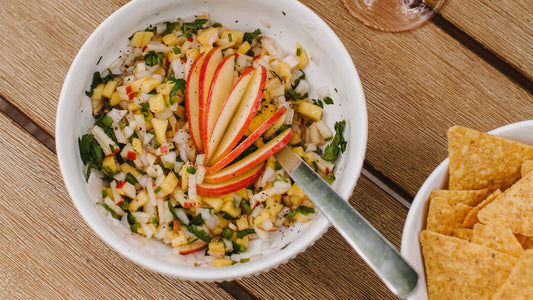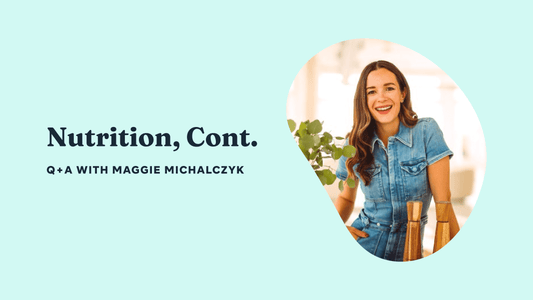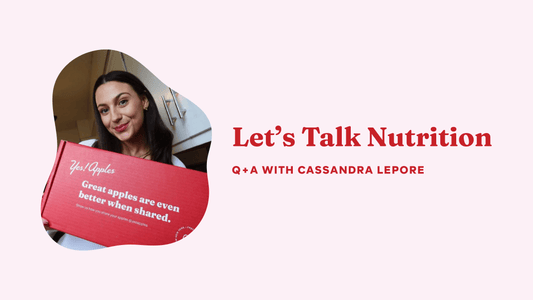Finally master the apple pie this year with that sought-after flaky crust and juicy-sweet apple filling!
Yes, there’s a LOT of information here—but it’s full of helpful tips and tricks on how to master each step of the apple pie process. Just take it slow, read each step through, and then come back to tackle the recipe. You got this friends! Let’s bake.
For the full recipe, click here!
Materials
- 9 in. pie pan, preferably non-stick
- Large skillet to cook apple filling
- Various sized mixing bowls
- Measuring cups
- Measuring spoons (love these adjustable spoons!)
- Rolling pin
- Spatula
- Pastry cutter or sharp knife
- Kitchen shears
- Pastry brush
- Optional: pie dough leaf stamps
The Pie Dough
My go-to recipe for pie dough comes from Erin McDowell at Food52. Check out the Best All Butter Pie Crust Dough recipe and check out her cookbook, The Book on Pie. It’s a pie-lovers dream filled with so many recipes, tips, and tricks to mastering pie!
Step 1: Mastering the Dough
The key to getting that sought-after flaky pie crust lies with the butter! You want to keep the butter as cold as possible throughout all stages of the assembly before it bakes. Cold butter releases steam during the bake, which puffs up your dough to make it super flaky.
So, before you get started: cut the unsalted butter sticks into smaller ½ in. cubes, place them on a small plate or in a small bowl, and freeze for about 5-10 minutes.
After whisking together flour and salt, you’ll want to toss the cubes of butter in flour to coat them. This creates a little barrier between the warmth of your hands and the butter, but also helps keep your butter from popping out later when you go to roll it.
Then, squish each cube of butter between your index finger and thumb to create flat little “shingles” of butter. I like to go through and squish each cube first, then do a final round of rubbing the butter into the flour. By the end, I’m left with plenty of flat shingles and smaller pea-sized piece of butter.
After you add the first ¼ cup of water, add in 1 tablespoon increments until the dough reaches the right consistency. It’s much easier to add water to a dry dough than it is to add flour to a wet one. Once the dough starts to come together, add the water slowly! (You can even dip your fingers in ice water as you handle the dough to help it come together without adding too much water by mistake.)
Split the dough into two discs—one for the crust and one for the top/lattice—before wrapping tightly in plastic wrap and chilling in the fridge for at least an hour.

For Extra-Flaky & Easy-to-Handle Dough
- After chilling for 1 hour, roll out one disc of dough at a time on a lightly floured surface until you have a 10-12 in. square.
- Fold the square in half, first from top to bottom and then side to side. Roll the layered dough into a 10-12 in. square again, then repeat the fold instructions once more.
- Wrap tightly in plastic wrap and chill in the fridge for 1 hour before using.
Trimming & Transferring the Crust
Use the photos below to guide your preparation of the bottom crust. You need 1-2 in. of overhang around the edge that will be crimped later.
Pro tip: rather than struggling to roll the dough into a perfect circle, roll it out to ¼ in. thickness, then place the 9 in. pie pan upside down in the middle and cut out a circle leaving an extra 1-2 in. overhang. You can use the scraps to make leaf cutouts on top!
When rolling the dough back on the rolling pin to transfer to the pie pan, lightly dust the dough and rolling pin with flour so it won't stick. Once you've successfully transferred the dough, help settle your dough into the pan so that it fills in all the natural crevices. Then, return to the fridge to keep the butter cold.

The Pie Lattice
If you choose to make a pie lattice, roll the second disc of dough into a large rectangle (roughly 12 in. x 14 in.) and cut lengthwise into (12) 1 in. strips. The dough should be about the same thickness as the base, around ¼ in.
Err on the side of making these strips longer so they fit across the pie pan. You can always trim off excess dough after assembling the lattice.

Step 2: Mastering the Filling
After you've peeled, cored, and thinly sliced the apples, toss them with lemon juice in a strainer and set over a bowl. This keeps the apples from browning while you prepare the other ingredients (but with Yes! Apples, I've truly never had an issue with browning—they keep fresh for so long!).
Pre-cooking the pie filling ensures that it's never undercooked when you bake the actual pie. This helps wrangle the juices, too—no soggy bottoms here, folks!
Choosing the Right Apple Variety
The best baking apples are ones that stay firm while cooking, but still cook down enough to create a saucy filling. You want to avoid apples that could become mushy when baked, like Red Delicious. You also want to find the right balance of sweet and tart to ensure your pie is complex in flavor.
Our favorite apple varieties for pie are Cortland, Golden Delicious, Honeycrisp, and Pink Lady. Try combining two varieties to create different flavor profiles!
Cooking the Apples
- In a large, deep skillet, melt butter over medium heat. Add apples and toss to coat. Add sugar, spices, and salt, then toss once more. Cook over medium for 8-10 minutes.
- Add apple cider vinegar and vanilla extract, then sprinkle in flour and 1 Tbsp. corn starch. Cook for an additional 3-5 minutes until mixture thickens, stirring occasionally. You can add an extra tablespoon of corn starch if needed.
- Remove from heat and cool completely before filling the pie crust. Cooling tip: spread the filling in an even layer on a baking sheet to cool even faster!

Step 3: Mastering the Assembly
Make sure the filling has cooled completely before pouring into the prepared crust. Use a spatula to spread the filling evenly.
Assembling the Lattice
- Evenly space out 6 of the strips horizontally across the pie pan.
- Lift 3 alternating strips all the way back on themselves until they're basically at the edge of the pie pan (lift the first strip, skip the second, lift the third, skip the fourth, lift the fifth, skip the sixth).
- Take one of the unused strips and lay perpendicular across the strips you just placed. Make sure this new strip is nestled against the folded back ones. Flip the folded strips over the new strip, creating the first section of lattice.
- Fold the other 3 strips back (skip the first strip, lift the second, skip the third, lift the fourth, skip the fifth, lift the sixth). Place another unused strip perpendicular across and nestle against the folded strips. Flip the folded strips back over.
- Alternate this pattern until all dough strips are latticed.
- Trim excess from the outside edges of the pan, then fold the bottom crust over the edges of the lattice (remember, we left a 1-2 in. overhang!). Fold and tuck inward while pressing to seal.

Crimping the Edges
My preferred method is below, but this article shows the crimping process and features other ways to shape the pie's edges!- With your non-dominant hand, form "pinchers" between your thumb and index finger. Rest these fingers on the outside edge of dough with fingertips pointing towards the middle of the pie.
- Using the index finger on your dominant hand, push the dough outward into the v-shaped space made by your "pinchers."
- The dominant hand will do most of the work. You'll only lightly press inwards with the non-dominant fingers. Shift your non-dominant hand and start the next crimp right where the previous one ended. Work around until you're back where you started.
The Egg Wash & Toppings
The egg wash is applied right before baking the pie. I like to go heavy on the egg wash because it makes the top crust dark and crispy. The more egg wash you apply, the faster the crust will brown. Keep this in mind as you bake and check the doneness after the first 30 minutes to make sure the pie doesn't burn.
Before baking, I like to sprinkle coarse Demerara or Turbinado sugar over the egg wash. It gives the pie a caramel-like crunch. You can also use granulated sugar if you can't find the others.
Step 4: Mastering the Bake
With most bakes, especially pies, you’ll see a range for the bake time. This is to account for the fact that not all ovens are create equally and are not always calibrated accurately. While your oven's built-in temperature gauge may read 425° F, it may actually be 5-10 degrees higher or lower. An oven thermometer is the key to more accurate bakes!
Visual cues are a helpful way to adjust for discrepancies in oven temperature. If you have to add time to the bake, you at least know what kind of browning to look for to indicate that your pie is finished.
How to Know Your Pie is Done
- The crust is evenly browned across the whole surface. If it appears splotchy or uneven, return to the oven.
- The filling will begin to bubble over the lattice. This, plus an evenly browned crust, is an indicator that the underside is fully cooked, too!
- If the crust starts to burn, but the filling has yet to bubble, cover the top and/or edges with foil or a pie shield. This protects the crust from burning while the filling continues to bake.





